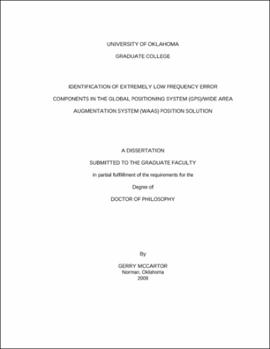| dc.contributor.advisor | Fagan, John E | |
| dc.creator | McCartor, Gerry Ray | |
| dc.date.accessioned | 2019-06-05T21:20:33Z | |
| dc.date.available | 2019-06-05T21:20:33Z | |
| dc.date.issued | 2009 | |
| dc.identifier | 99177984602042 | |
| dc.identifier.uri | https://hdl.handle.net/11244/320318 | |
| dc.description.abstract | The Wide Area Augmentation System (WAAS) was intended to "augment" the basic Global Positioning System (GPS) navigation service to the necessary level to support precision approach operations equivalent to the Instrument Landing System (ILS). For a variety of reasons, this has not been achieved. Full implementation of the system will require improvements to all four principal components: accuracy, integrity, availability, and continuity [7], [9]. Previous work has addressed integrity problems by improved algorithms [12]. Availability and continuity have been and may continue to be improved by increasing the number of Wide-area Reference Stations (WRSs) and expanding and improving the geostationary platforms that broadcast the WAAS corrections. This dissertation, for the first time, addresses the needed improvements to the accuracy component by identifying extremely low frequency error components in the WAAS position solution that are of significant magnitude, representing between 10 and 20 per cent of the total error. | |
| dc.description.abstract | This work, for the first time, examines data collected over a multi-year period by several different types of WAAS receivers installed at diverse geographical locations across the WAAS coverage area. This was done both to eliminate any localized phenomena and to allow examination of the data for geographic or seasonal trends. The dissertation identifies hitherto undetected and ignored common spectral error components in all the data. A graphical representation and two separate spectral decomposition techniques are applied to the data to verify the presence of the error components. | |
| dc.description.abstract | Means of applying corrections for these errors are presented as well as areas of future research and investigation. If the corrections identified by this dissertation can be generally applied, the accuracy component of the WAAS will achieve the level necessary to support ILS quality precision approach operations and support further improvements to the integrity component. The corrections that have been identified in this dissertation can be easily implemented in the master station code managed by Raytheon. This will significantly improve the acceptability and usage of WAAS and lead to a cascade of system improvements that can enhance the capabilities of the Federal Aviation Administration's NextGen (Next Generation Air Transportation System) [32]. | |
| dc.format.extent | 95 pages | |
| dc.format.medium | application.pdf | |
| dc.language | en_US | |
| dc.relation.requires | Adobe Acrobat Reader | |
| dc.subject | Instrument landing systems | |
| dc.subject | Navigation (Aeronautics) | |
| dc.subject | Air traffic control | |
| dc.subject | Global Positioning System | |
| dc.subject | Landing aids (Aeronautics) | |
| dc.title | IDENTIFICATION OF EXTREMELY LOW FREQUENCY ERROR COMPONENTS IN THE GLOBAL POSITIONING SYSTEM (GPS)/WIDE AREA AUGMENTATION SYSTEM (WAAS) POSITION SOLUTION | |
| dc.type | text | |
| dc.type | document | |
| dc.thesis.degree | Ph.D. | |
| ou.group | College of Engineering::School of Electrical and Computer Engineering | |
